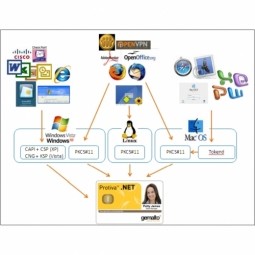Technology Category
- Application Infrastructure & Middleware - Data Exchange & Integration
- Application Infrastructure & Middleware - Middleware, SDKs & Libraries
Applicable Industries
- Education
- Life Sciences
Applicable Functions
- Logistics & Transportation
Use Cases
- Last Mile Delivery
- Real-Time Location System (RTLS)
Services
- System Integration
About The Customer
United BioSource Corporation (UBC) is a pharmaceutical support enterprise that has been providing patient support services for nearly 20 years. They work with partnering pharmaceutical companies to help patients overcome the administrative, financial, and clinical hurdles to starting and staying on complex drug therapies. While drug companies make up UBC’s client base, UBC case managers render support services directly to individual prescribers and patients. Services provided by UBC, including co-pay card enrollments, nurse education services and similar benefits, are delivered as a free service to the patient and/or prescriber.
The Challenge
United BioSource Corporation (UBC), a pharmaceutical support enterprise, was facing significant challenges with its patient consent process. The paper-based system was not only costly but also time-consuming, often taking between 4-11 days for completed forms to arrive back at UBC. This delay was detrimental to UBC's ability to swiftly deliver services to patients. Additionally, the cost of printing and shipping the consent forms was adding up, with UBC spending upwards of $47 to obtain a traditional patient’s consent. The paper-latent consent process was not only causing extraneous costs but also impeding UBC's ability to serve patients promptly.
The Solution
UBC turned to Nintex AssureSign to expedite the patient consent process. Nintex AssureSign’s open and flexible APIs allowed UBC to integrate an electronic signature solution into their existing UBC Pathways™ Connected Health solution. This custom-built eSign integration enabled case managers to send consent paperwork easily and electronically, transforming a 4-to-11-day process into a matter of minutes. The simplicity of Nintex AssureSign’s eSignature design created a signer-friendly experience, even for patients with limited exposure to technology. Real-time document tracking and analytics enabled case managers to identify outstanding steps within a patient’s review and eSigning process, making proactive service effortless. Nintex AssureSign’s unique pricing model also helped UBC reduce annual printing and shipping costs.
Operational Impact
Quantitative Benefit

Case Study missing?
Start adding your own!
Register with your work email and create a new case study profile for your business.
Related Case Studies.

Case Study
Corporate Identity Solution Adds Convenience to Beckman Coulter
Beckman Coulter wanted to implement a single factor solution for physical and remote logical access to corporate network. Bechman Coulter's users were carrying smart card badges for doors, but also needed a one-time password token to access to our corporate network when they were not in the office. They wanted to simplify the process.

Case Study
IoT platform Enables Safety Solutions for U.S. School Districts
Designed to alert drivers when schoolchildren are present, especially in low-visibility conditions, school-zone flasher signals are typically updated manually at each school. The switching is based on the school calendar and manually changed when an unexpected early dismissal occurs, as in the case of a weather-event altering the normal schedule. The process to reprogram the flashers requires a significant effort by school district personnel to implement due to the large number of warning flashers installed across an entire school district.

Case Study
Embracing Business Success in Real Time
· Increase control over growing Big Data to improve business decisions · Manage data for 28,000 biotechnology stockkeeping units in the fields of microbiology, molecular biology, animal cell cultures, plant tissue cultures, and lab ware for laboratory chemicals · Accelerate report generation and analysis with real-time data

Case Study
Revolutionizing Medical Training in India: GSL Smart Lab and the LAP Mentor
The GSL SMART Lab, a collective effort of the GSL College of Medicine and the GSL College of Nursing and Health Science, was facing a challenge in providing superior training to healthcare professionals. As clinical medicine was becoming more focused on patient safety and quality of care, the need for medical simulation to bridge the educational gap between the classroom and the clinical environment was becoming increasingly apparent. Dr. Sandeep Ganni, the director of the GSL SMART Lab, envisioned a world-class surgical and medical training center where physicians and healthcare professionals could learn skills through simulation training. He was looking for different simulators for different specialties to provide both basic and advanced simulation training. For laparoscopic surgery, he was interested in a high fidelity simulator that could provide basic surgical and suturing skills training for international accreditation as well as specific hands-on training in complex laparoscopic procedures for practicing physicians in India.

Case Study
Implementing Robotic Surgery Training Simulator for Enhanced Surgical Proficiency
Fundacio Puigvert, a leading European medical center specializing in Urology, Nephrology, and Andrology, faced a significant challenge in training its surgical residents. The institution recognized the need for a more standardized and comprehensive training curriculum, particularly in the area of robotic surgery. The challenge was underscored by two independent studies showing that less than 5% of residents in Italian and German residency programs could perform major or complex procedures by the end of their residency. The institution sought to establish a virtual reality simulation lab that would include endourological, laparoscopic, and robotic platforms. However, they needed a simulator that could replicate both the hardware and software of the robotic Da Vinci console used in the operating room, without being connected to the actual physical console. They also required a system that could provide both basic and advanced simulation training, and a metrics system to assess the proficiency of the trainees before they performed surgical procedures in the operating theater.

Case Study
Edinburgh Napier University streamlines long-distance learning with Cisco WebEX
• Geographically dispersed campus made in-person meetings costly and inconvenient.• Distance-learning programs in Malaysia, India, and China required dependable, user-friendly online tools to maximize interaction in collaborative workspaces.• Virtual learning environment required a separate sign-in process, resulting in a significant administrative burden for IT staff and limited adoption of collaboration technology.



